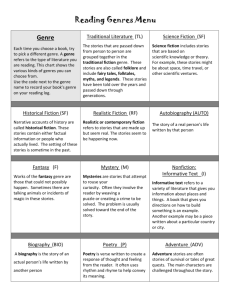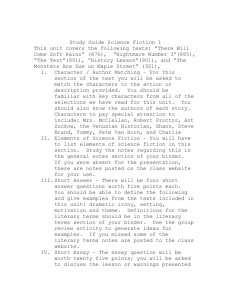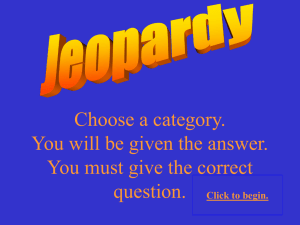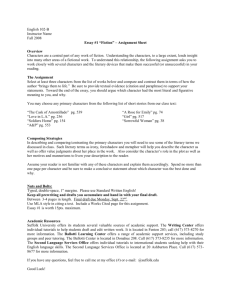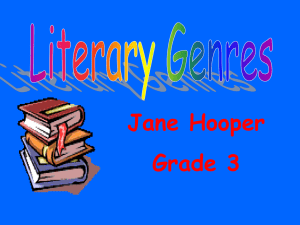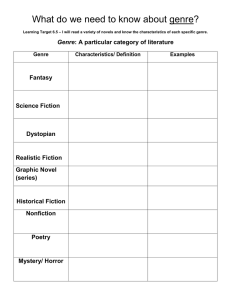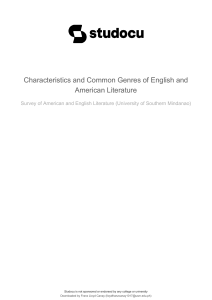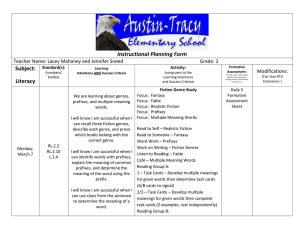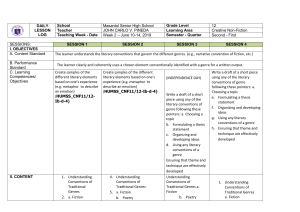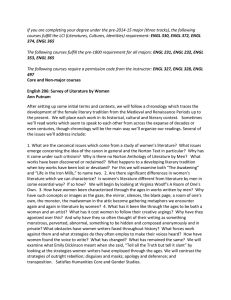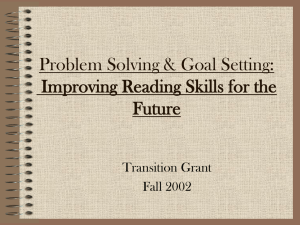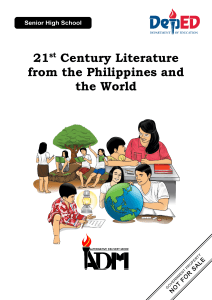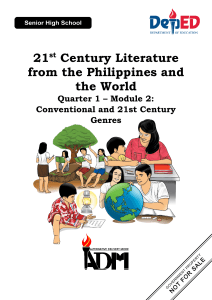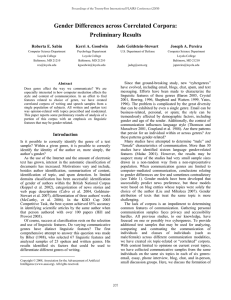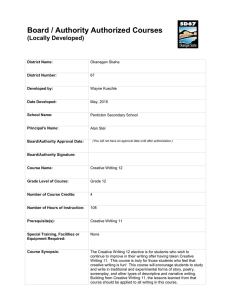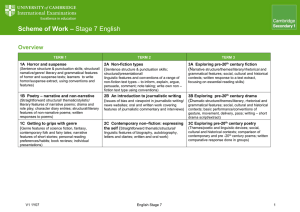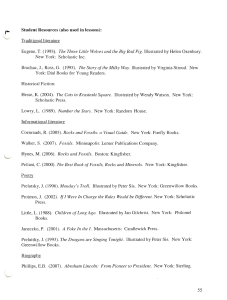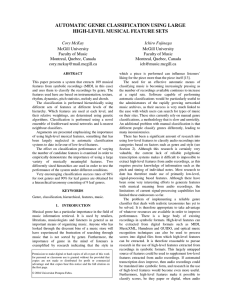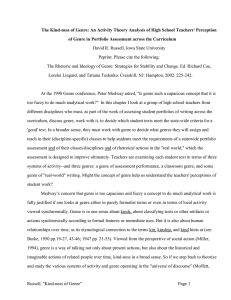Semester Exam Review
advertisement
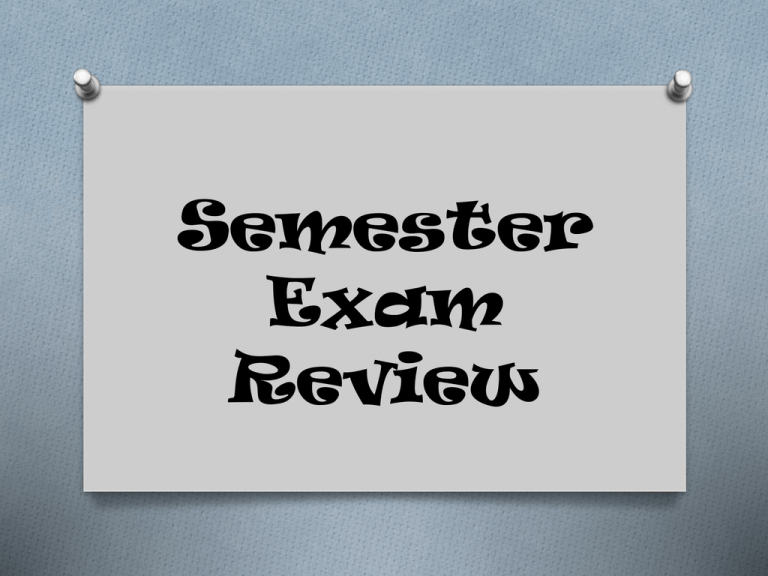
Semester Exam Review Vocabulary O Lesson 1- O 1) blurb-the description of a book that appears on the inside front O cover or the back of the book O 2) fiction-works that present events or content that are imaginary O 3) nonfiction-works that present events or content that are based on fact O Lesson 2- 4) genre-a type of writing that shares common characteristics O Lesson 65) narrative-a story of events; in most narratives, the events occur chronologically-something happens first, second, third, etc. 6) narrative drive-the desire on the part of the reader to find out how a good story ends-what happens and why Vocabulary cont. O Lesson 7- O 7) protagonist-the main character O 8) point of view-the perspective from which a story is told O 9) omniscient-all knowing O 10) first person-told by a character who is in the story; uses the word "I" O 11) third person limited omniscient-told by someone who is not in the story, but is limited to the information, insights, and feelings held by a single character; uses the words "she", "he", and "they" O 12) third person omniscient-told by someone outside the story who knows all of the information about all of the characters and what they do, say, think, and feel Vocabulary cont. O Lesson 8O 13) plot-all of the events in a story O 14) turning point-the event, usually early in a narrative, that initiates or indicates the problem that must be solved in the story O 15) crisis point (or "climax")-the event, usually late in a narrative, that most dramatically affects the outcome of the story Vocabulary cont. O O O O O O O O Lesson 916) introduction- the beginning part of a text that leads the reader to the main part 17) rising action- the series of events that leads to the crisis point; often this is a series of events that challenge the protagonist 18) resolution-the ending or the outcome; the last part of the story Lesson 1119) essay- a short, literary composition on a specific theme or subject 20) personal essay-a short, literary composition that presents a personal perspective on a specific theme or subject; often written from the first person, using “I” 21) topical organization-writing with topical organization moves from one topic to another in a logical sequence, topic by topic Vocabulary cont. O O O O O O O O O O O Lesson 1222) topic-the subject of an essay or informational presentation 23) subtopic-a part of the subject 24) transition- a change from one thing to another; transition words signal a change in ideas, information, or subtopics within an essay or presentation 25) summary-a short version of a story, presentation, essay, or incident that includes the main points Lesson 1326) efferent reading- reading with attention to understanding, analyzing, and/or learning information 27) aesthetic reading-reading with attention to effects, inferences, and reactions to text Lesson 1428) text features-the distinctive features of a text; for example, the inclusion of graphics, fonts, definitions, bibliographies, etc. 29) font-the size and type of letters used in text Literary Vocabulary O l- alliteration- the repetition of identical or similar consonant sounds, normally at the O beginnings of words. O 2-hyperbole- a deliberate, extravagant, and often outrageous exaggeration. It may be used for either serious or comic effect. O 3-metaphor- a figurative use of language in which a comparison is expressed without the use of a comparative term like “as,” “like,” or “than.” A simile would say, “night is like a black bat”; a metaphor would say, “the black bat night.” Literary Vocabulary cont. O 4-simile- a directly expressed comparison; a figure of speech comparing two objects, usually with “like,” “as,” or “than.” O 5- onomatopoeia- the use of words whose sound suggests their meaning. Examples are “buzz,” “hiss,” or “honk.” O 6- personification- a kind of metaphor that gives inanimate objects or abstract ideas human characteristics. Plot Map Point of View GENRES Fiction Code Genre F Fantasy RF Realistic Fiction Mystery M TL Traditional Literature HF Historical Fiction SF Science Fiction Definition A story including elements that are impossible such as talking animals or magical powers. Makebelieveis what this genre is all about. A story using made-up characters that could happen in real life. A suspenseful story about a puzzling event that is not solved until the end of the story. Stories that are passed down from one group to another in history. This includesfolktales, legends, fables, fairy tales,tall tales, andmythsfrom different cultures. A fictional story that takes place in a particular time period in the past. Often the setting is real, but the characters are made up from the author’s imagination. A type of fantasy that uses science and technology (robots, time machines, etc.) GENRES cont. Nonfiction Co de Genre Definition I Informational Texts that provide facts about a variety of topics (sports, animals, science, history, careers, travel, geography, space, weather, etc.) B Biography The story of a real person’s life written by another person. AB Autobiography The story of a real person’s life that is written by that person. GENRES cont. Other Genre Co de P Genre Definition Poetry Poetry is verse written to create a response of thought and feeling from the reader. It often uses rhythm and rhyme to help convey its meaning. Conflicts • Character vs. Character (External) • Character vs. Nature (External) • Character vs. Society (External) • Character vs. Self (Internal) Signal Words that Show Chronology Then Next Finally At last First Secondly In conclusion While After that Until then As soon as At this point In the end Previously Afterwards Meanwhile Already Subsequently Signal words that show sequence Beginning O First O At first O In the beginning O The first subtopic was O Initially Middle O O O O O O O O O O O Then After that Also Second For example Furthermore Additionally The next subtopic Following Next Third End Finally O At the end O In conclusion O Conclusively O


